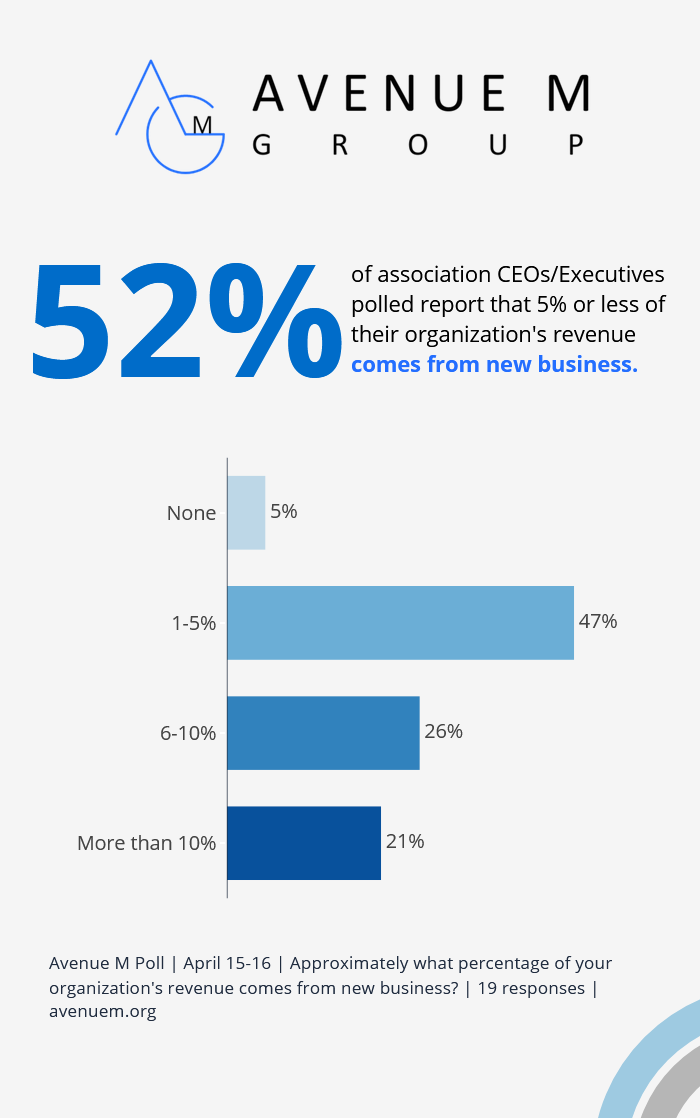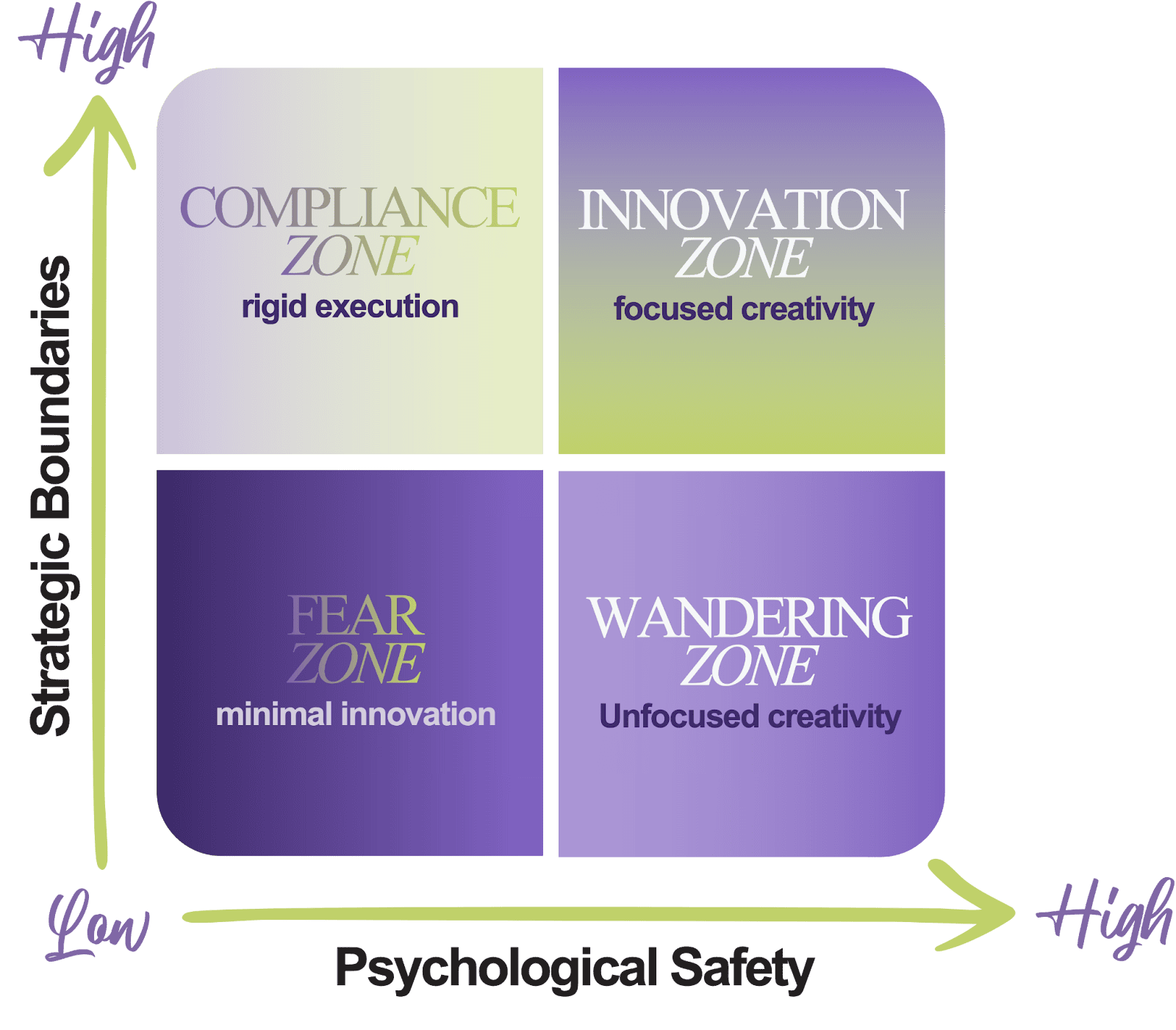A new Avenue M quick poll shows most associations are playing it safe—with minimal revenue from new business. In today’s volatile landscape, that caution could cost more than it saves. Real growth calls for bold moves and fresh ideas.
To state the obvious, there’s a lot of unpredictability in the world right now. Added to that, economic shifts, evolving member expectations, and the nonstop pace of digital change are putting associations under more pressure than ever to adapt: Relying too heavily on traditional revenue streams is not a safe bet—especially when disruption is so pervasive.
 Now is the time for organizations to innovate and diversify their portfolios to ride out the rapids with agility. However, when association executives were asked in a recent Avenue M quick poll to gauge what percentage of their organization’s revenue comes from new business, most executives said their organizations are bringing in only modest revenue from new business efforts.
Now is the time for organizations to innovate and diversify their portfolios to ride out the rapids with agility. However, when association executives were asked in a recent Avenue M quick poll to gauge what percentage of their organization’s revenue comes from new business, most executives said their organizations are bringing in only modest revenue from new business efforts.
More than half (52 percent) said new business accounts for just 5 percent or less of their revenue. Another 26 percent said 6 to 10 percent, and only 21 percent reported more than 10 percent. This suggests that while many organizations are exploring new revenue streams, significant returns remain relatively rare.
However, it is of note that discussing revenue sources and new business may be difficult for some organizations: For example, it may be hard to judge what counts as new business, or there may be a lack of easily digestible data when it comes to where revenue actually comes from. One executive pointed out, “This is a tough question. Sometimes I think of new business as getting new sponsors or exhibitors because it does extend our reach. We are launching new certifications levels that have the potential of bringing in entirely new revenue.”
New Ideas, Modest Gains
Executives shared a range of efforts they’ve implemented to generate new revenue: sponsored webinars, digital advertising, local events, financial planning services, podcast sponsorships, and revamped versions of older programs. Most of these initiatives brought in between 1 to 10 percent in new revenue. That’s not nothing—but it suggests that a lot of organizations are still playing it safe.
Even so, there were a few bright spots. Credentials stood out, driving more than 10 percent of revenue for one association. New seminars and fresh, targeted content also delivered solid results for a couple of respondents. The takeaway? When associations invest in meaningful, high-value offerings, the returns can be real—and significant.
It’s not just about chasing new revenue for growth’s sake. Diversifying a portfolio is about long-term stability. If one revenue stream takes a hit—say, a major event gets canceled or membership numbers drop—others can help keep things afloat.
New programs and services can also bring in new audiences, open up partnership opportunities, and create more value for members. And in today’s world, where member needs and expectations are constantly shifting, that kind of adaptability isn’t just nice to have—it’s essential.
But where do you start? How do you create a culture where innovation not only thrives but is instrumental in helping you diversify your revenue streams? The answer lies in defining and articulating your constraints or boundaries and providing your team with the opportunity to test new ideas, even if some of them will fail.
This chart shows the four zones where teams can land depending on two conditions: psychological safety and clear boundaries.

When both are low, you’re in the Fear Zone: people play it safe or stick with what they know. When safety is high but boundaries are fuzzy, you get the wandering zone: lots of ideas, but no focus. But when both safety and boundaries are high, you hit the Innovation Zone. That’s the sweet spot. That’s where you want to aim.
Because when people know where the edges are, they’re more willing to explore all the space in between and identify new opportunities for revenue growth.
If you’re looking to unlock real innovation in your organization, this is where to start.
For years, we’ve been told that creativity thrives with more freedom and more resources. But I’ve observed that people are likelier to play it safe when they don’t know how far they can go. This is true even if they work in a culture that embraces psychological safety and encourages accountable risk-taking.
Associations that stay nimble and willing to experiment are likelier to thrive in the face of change. Those who stick too closely to the old ways risk being left behind.
What’s Working—and Why
The initiatives that performed best in the poll weren’t just new—they were useful. Credentials help professionals get ahead and provide ongoing value. Seminars and content that tap into timely, relevant topics—especially when delivered in flexible, accessible ways—can also provide value.
These offerings meet real needs, and that’s what makes the difference. They’re not just repackaged versions of the same old thing—they’re carefully designed, thoughtfully executed, and member-focused.
The quick poll results show that many associations are starting to try new things, which is promising. But they also suggest there’s plenty of room to go further. Because in a rapidly changing world, standing still might be the biggest risk.
Want to participate in future text polls? You can sign up HERE.
For more insights on ways to diversify and innovate, read Avenue M’s quick summaries of the following resources, and click the links below.
Report: Association Leaders Open to Mergers
Association leaders are feeling upbeat about their finances—and they’re looking at tech and partnerships as smart ways to drive more revenue. In a new survey, 80 percent say they plan to boost spending on things like AI, data tools, and CRMs to better connect with members and deliver more value.
At the same time, nearly 80 percent are open to merging or teaming up with other associations in the next few years—not out of panic—but to grow faster, reach more people, and streamline operations.
Even though agility and talent retention are still big challenges, many leaders see tech as the way to stay flexible and competitive so they can keep moving forward and growing.
Courageous Growth: Six Strategies for Continuous Growth Outperformance
When things get uncertain, playing it safe might help organizations hang on—but it rarely leads to standout growth. McKinsey research shows that the companies that consistently pull ahead have one key thing in common: courage. These leaders stick with bold strategies even when the road gets bumpy. Here are three ways they make it work.
- Foster a culture of innovation.
Growth leaders invest heavily in R&D, digital capabilities, analytics, and AI—embedding innovation into their culture, setting bold targets, and embracing smart risk-taking. - Accelerate core growth with data and AI.
Outperformers supercharge their core business through digital transformation, using analytics and AI to boost productivity and build capabilities that create lasting competitive advantage. - Divest strategically to fuel growth.
High-growth organizations aren’t afraid to shrink smartly—spinning off non-core assets and reallocating resources to areas with greater potential and stronger market fit.
Want to be the first to be notified about articles like this? You can learn more about Avenue M’s texting poll service HERE.
Contributors: Sheri Jacobs, FASAE, CAE & Lisa Boylan
Image: Adobe Stock Photo